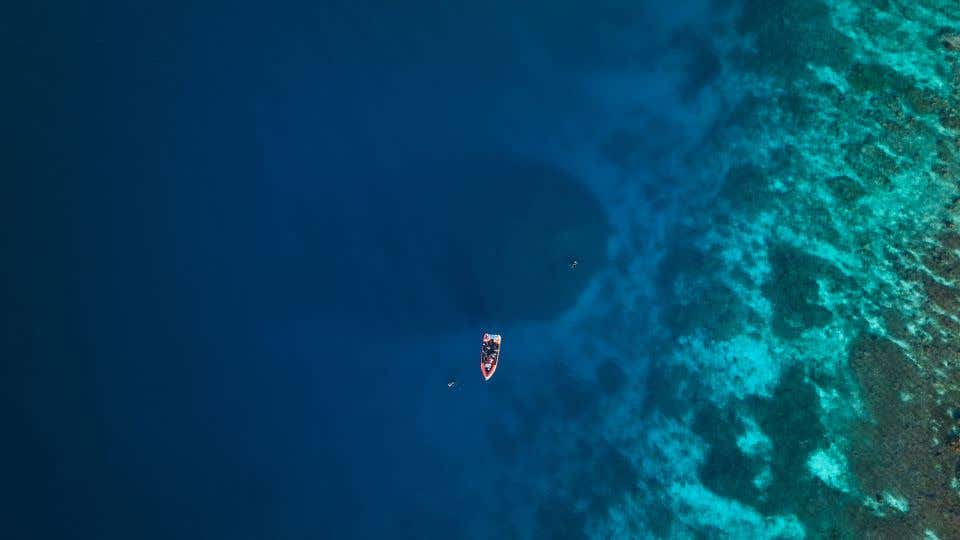World’s largest coral colony discovered in the Pacific ocean – viewable from space
Scientists unveil the largest coral colony, thriving near the Solomon Islands. A symbol of hope for marine ecosystems amid climate threats.

Hidden for centuries, the world’s largest coral colony has been discovered near the Solomon Islands. (CREDIT: Steve Spence / National Geographic)
For centuries, an extraordinary coral lay hidden beneath the Pacific Ocean’s surface near the Solomon Islands, growing unnoticed on the seabed.
Now, scientists from National Geographic’s Pristine Seas program have uncovered this massive living structure, the largest coral colony ever recorded. Measuring 111 feet wide, 104 feet long, and 18 feet tall, this coral dwarfs even the blue whale, the planet’s largest animal, and is so immense it can be seen from space.
Initially mistaken for a shipwreck, the coral was spotted during an expedition to study ocean health. “In the first second, I realized I was looking at something unique,” said underwater cinematographer Manu San Félix, who dived to investigate.
From above, the coral appears as a vast, undulating brown mass. Up close, its surface transforms into a vibrant mosaic of colors—splashes of yellow, blue, and red breaking up its earthy hues. Lead scientist Molly Timmers likened it to “melted ice cream spreading forever along the seafloor.”
This ancient coral is a single organism formed by a network of nearly a billion tiny polyps, which have grown together for 300 to 500 years. Unlike coral reefs made up of numerous colonies, this standalone structure has grown continuously for centuries, creating a unique habitat teeming with life.
A Thriving Underwater Ecosystem
Beyond its remarkable size, the coral plays a vital ecological role. It provides essential shelter and breeding grounds for a wide variety of marine species, including fish, crabs, and shrimp. “It’s pulsing with life and color,” said Enric Sala, founder of Pristine Seas. This living structure not only supports marine biodiversity but also serves as a natural archive of ocean conditions, offering scientists valuable insights into centuries of environmental changes.
The Solomon Islands, located within the Coral Triangle, are renowned for their rich marine biodiversity. With over 490 species of hard and soft corals, the region boasts the world’s second-highest coral diversity.
Related Stories
Despite this, the coral’s existence was unknown even to the local community, highlighting the vast mysteries still hidden beneath the ocean’s surface. “This discovery opens doors of knowledge,” said Collin Beck, a top official in the Solomon Islands, emphasizing the need for further research to understand the region’s biodiversity.
A Testament to Resilience
The coral’s survival through centuries of environmental changes is a testament to its resilience. “Corals are effectively immortal,” said David M. Baker, a coral reef expert at the University of Hong Kong. The fact that this coral has thrived despite significant shifts in ocean conditions underscores its adaptability and the exceptional environmental conditions it must enjoy.
However, even this remote giant is not immune to the threats facing coral ecosystems worldwide. Overfishing, industrial pollution, and sewage can disrupt the delicate balance of coral habitats.
In particular, species such as sea cucumbers and giant clams play crucial roles in maintaining ecosystem health, filtering bacteria and cleaning sediments. Their removal can have cascading effects on the entire reef system.
The Looming Threat of Climate Change
The greatest threat to corals, including this newly discovered giant, is climate change. Rising ocean temperatures, driven by the fossil fuel economy, have triggered widespread coral bleaching events. Bleaching occurs when corals, stressed by heat, expel the symbiotic algae that provide them with food and color, leaving them vulnerable and often leading to death.
The world is currently experiencing its fourth global coral bleaching event, with reefs in at least 62 countries and territories affected. “Despite its remote location, this coral is not safe from global warming,” said Sala.
According to NOAA, more than 40% of warm-water reef-building coral species now face extinction, primarily due to climate change. Derek Manzello of NOAA’s Coral Reef Watch noted, “The ongoing survival of corals is in jeopardy.”
Yet, the coral’s resilience offers a glimmer of hope. Emily Darling, director of coral reefs at the Wildlife Conservation Society, called the discovery “a bright spot for coral reef survival.”
The health and longevity of this coral suggest that certain environments, particularly in deeper waters, may provide refuges from the accelerating impacts of climate change. This aligns with research indicating that the Coral Triangle, which includes the Solomon Islands, may be more resistant to bleaching.
A Call to Action
The discovery comes as global leaders gather for COP29 in Baku, Azerbaijan, to discuss climate action and mobilize funding to help vulnerable nations combat and adapt to climate change. This giant coral stands as a potent symbol of both hope and urgency.
“Finding this coral is a reminder of what we can still save,” said Sala. Protecting such ecosystems requires a concerted effort, combining local conservation measures with global initiatives to reduce carbon emissions and mitigate climate change.
For the Solomon Islands, this monumental find offers new opportunities. It could attract researchers and eco-tourists, boosting conservation funding and raising awareness about the region’s unique biodiversity.
“This is something huge for our community,” said Dennis Marita, the country’s director of culture at the Ministry of Culture and Tourism. The coral has already drawn international attention, highlighting the Solomon Islands as a crucial site for marine conservation.
While the challenges are immense, the discovery underscores the resilience of life in the ocean. The survival of this coral, a living witness to centuries of environmental shifts, provides a rare and powerful message: it’s not too late to protect, conserve, and restore the oceans.
Note: Materials provided above by The Brighter Side of News. Content may be edited for style and length.
Like these kind of feel good stories? Get The Brighter Side of News' newsletter.
Joshua Shavit
Science & Technology Writer | AI and Robotics Reporter
Joshua Shavit is a Los Angeles-based science and technology writer with a passion for exploring the breakthroughs shaping the future. As a contributor to The Brighter Side of News, he focuses on positive and transformative advancements in AI, technology, physics, engineering, robotics and space science. Joshua is currently working towards a Bachelor of Science in Business Administration at the University of California, Berkeley. He combines his academic background with a talent for storytelling, making complex scientific discoveries engaging and accessible. His work highlights the innovators behind the ideas, bringing readers closer to the people driving progress.



